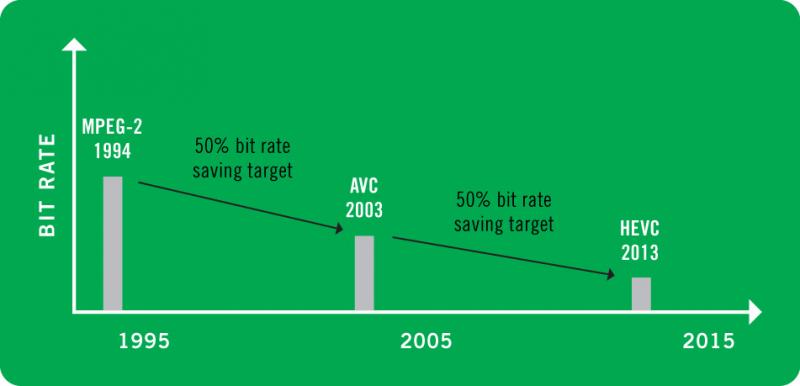Securing rights to efficient compression is the holy grail of multiplatform video delivery
For today’s content owners and broadcasters interested in serving video to consumers’ mobile and fixed devices with new types of IP-based multiplatform video delivery business models, the holy grail of success is clearly compression. You can’t move the large amounts of data, and thousands of video files, now being demanded by the paying public without adequate bandwidth. At IBC show in Amsterdam this past week, High Efficiency Video coding (HEVC), also known as the H.265 standard or “MPEG-5,” was being marketed as that ideal solution.
“Compression is now more important than ever before,” said Patrick Harshman, president and CEO of Harmonic, “both for service providers and companies like ours looking to support them. Without compression we run out of bandwidth. It’s that simple.”

HEVC is said to reduce the data rate needed for video coding by 50 percent when compared to the current state-of-the-art, H.264 (MPEG-4) while delivering better image quality. That extra bandwidth is sorely needed, as files get bigger and ever greater in number.
There were new hardware-based compression boards based on it, software algorithms that take advantage of it and newly emerging decoding technology to enable all of those video files to be displayed on Ultra HD TVs, computers, tablets and smart cell phones. And it’s not just about the highest resolution; HDTV will also benefit greatly from carefully compressed and highly automated technology platforms. Most venders at the show said that the cloud, that is, remotely located transcoding farms, will play a large role in helping to deliver video to so many devices at the same time.
What’s clear is that there will be many devices in the marketplace for broadcasters to serve. Ericsson, which has developed its own AVP4000 compression chip that supports HEVC, said that by the year 2020 there would be some 50 billion video-enabled connected devices. That’s a lot of files to serve, and it has to be done quickly and seamlessly to the viewer. Compression is the only practical way for content distributors to build out their next-generation platforms.
While it was clear from walking the exhibit floor in Amsterdam that HEVC encoding and decoding technology is now “ready for primetime” as Sam Blackman, CEO of Elemental technologies put it, the licensing negotiations now underway between MPEG LA, the standardizing body, and those that would implement the patented technology into their products (consumer electronics companies and broadcast equipment suppliers), are holding back real-world deployments.

According to Blackman, companies like Apple, Samsung and others now have the technology to utilize HEVC, but they don’t dare for fear of having to pay billions in licensing fees. Although there has been no official comment on the negotiations, word on the street is that MPEG LA is seeking a $20 million cap on single users, whereas they receive roughly a $7 million cap for the use of H.264 today. The big difference reflects the potential multiple uses that new IP-based video services will require in the future.
“We’re all waiting for the word on when we can begin deployments,” Blackman said. “I know we have customers interested in getting started and reaping the benefits that HEVC compression brings.”
At its exhibit booth, Elemental showed demonstrations of great-looking 1080p30 HD pictures running at 2.8Mb/s. This was real-time encoding of on-demand material. At 60fps, Elemental’s vice president of marketing, Keith Wymbs, said they could get great results at about 15Mb/s. He said field tests have already begun at a major satellite broadcaster in the U.S.
[Of note, it was explained that 8-bit processing works well with HD material but shows some “banding effect” issues when compressing the larger data rates of 4K materials. A 10-bit processor tends to smooth out the artifacts left by 8-bit technology but requires 20 percent more computer processing power.]
Licensing aside, there were many examples of decoding technology using the HEVC scheme. Samsung showed an 85in LED 4K TV with a complementary HEVC-enabled STB in its booth, and the compressed pictures looked stunning. There were many demos of live satellite-delivered 4KTV shown by other companies (ATEME, Panasonic, Sagecom, SES, Sony and others) as well, in addition to new rack-mountable HEVC products from Aspera, Envivio, Ericsson, Fraunhofer Institute, Harmonic and Thomson, to name a few.
In another example (for mobile video applications), a Silicon Valley-based company named Squid Systems showed an HEVC software decoder in tandem with Harmonic hardware and mobile decoding software from NXP Software at the show. Like others in the space, Squid offers HEVC decoders on CPU and CPU+GPU technology using openCL for platforms based on ARM Cortex A-Series processing cores. It also markets |encoders with Intel’s Atom chip inside (for mobile) and encoders based on multicore X86 processors. Demos at the booth showed visual examples of 720p30 and 1080p30 video encoded at very low data rates by Harmonic's encoders, decoded on mobile devices using the Squid HEVC decoder.

Also for video display on smartphones, HEVC software from another Silicon Valley-based company called VisualOn was shown implemented in the new G2 smartphones from LG and the video quality looked quite good. As a result, the company said, consumers will experience optimized data usage, higher resolution video streaming, efficient media storage and seamless playback.
And there were many more examples, proving that HEVC technology, which was officially standardized in January of this year, is maturing at a rapid pace.
"To provide an excellent consumer experience and achieve quick industry adoption HEVC encoders and decoders must interoperate seamlessly from sub-HD to full-HD resolution on current and future mobile devices," said Dr. Renga Sundararajan, vice president of products and marketing at Squid Systems.
Another major issue that HEVC brings up is the need for all of these OTT platforms to move to a progressive scan format. H.265 coding doesn’t support interlacing. That’s because all new display devices and most capture devices inherently use progressive scanning.
Bruce Devlin, chief technology officer at AmberFin — and co-author of the MXF specification — said that while the professional content creation industry is still generating more 1080i material every year than progressive material, good quality deinterlacing is critical to the success of HEVC in professional deployments. Addressing this issue at IBC, AmberFin showed a software-based deinterlacer (as part of its iCR multichannel processing platform) that the company said helps HEVC look great when applied to all types of content and distribution platforms.
Basically, Devlin said broadcaster employing progressive techniques in their distribution platforms would be good for their OTT business models in the long run.
"We really don't need to rely on interlacing any more," he said. "We have far better options that use modern solid-state electronics and digital processing, with true progressive scanning and without compromise. HEVC will, I hope, be one of the last nails in the coffin of interlace.”
This would mean that networks such as CBS and NBC, which have standardized their traditional television infrastructures on the 1080i HD format, would be wise to rethink their technical operations. ABC and Fox use the 720p format for their HD broadcasts.
So, while the HEVC licensing issues are sorted out, broadcasters have many options to consider in terms of compression technology they want to deploy: hardware versus software; GPU versus CPU platforms; 8-bit versus 10-bit processing; and cloud versus on-premise file processing. With so many players currently vying for this multiplatform delivery pie, there’s bound to be some consolidation. It’s also likely that this time next year a major equipment vendor such as Harris Broadcast or Miranda Technologies (owned by Belden) will acquire the technology of one of these Silicon Valley HEVC providers.
Many predict “real-world” deployments of HEVC H.265-based IP platforms to begin by the middle of next year. The goal of course is to leverage HEVC compression to improve the efficiency of OTT content delivery and support a wide range of compelling services that generate new revenue in the connected universe.
Judging from this year’s IBC Show, the broadcast equipment industry is ready.
Get the TV Tech Newsletter
The professional video industry's #1 source for news, trends and product and tech information. Sign up below.
